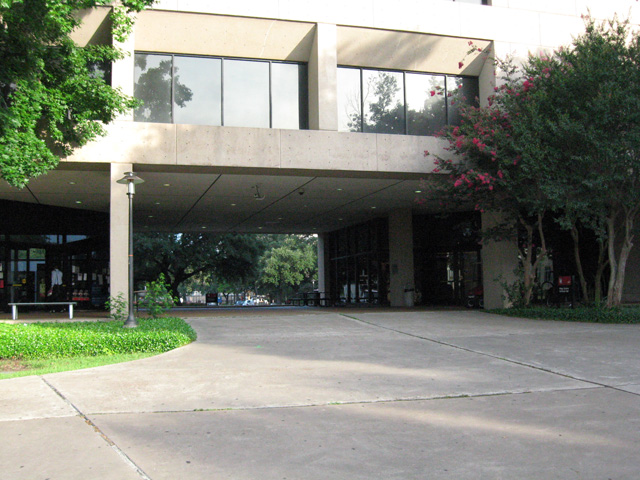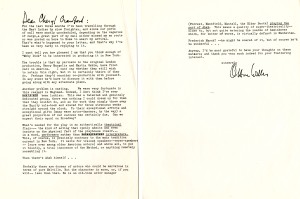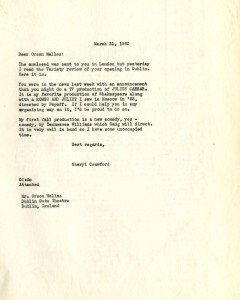
The recent post about Philip G. Hoffman Hall (PGH) failed to answer an important question: Why does it have a big hole in it? As with most cosmic questions, the answer to this one is that “it’s all connected.” In this case, PGH and its hole are connected to the change in the university’s master plan in the mid 1960s.
![1967 aerial view shows UH buildings arranged around several formal axes [UH Photographs Collection]](http://weblogs.lib.uh.edu/speccol/files/2014/05/UH-campus-1967-300x190.jpg)
UH Campus looking east (1967). Note street between Anderson Library and Ezekiel Cullen Building. UH Photographs Collection
Before the change in the master plan, a street ran through what is now Butler Plaza and passed between the Ezekiel Cullen Building and Anderson Library. See the 1967 aerial view of the campus. University planners decided to remove the street to create the plaza, and this required a new building opposite the library to provide a sense of enclosure.
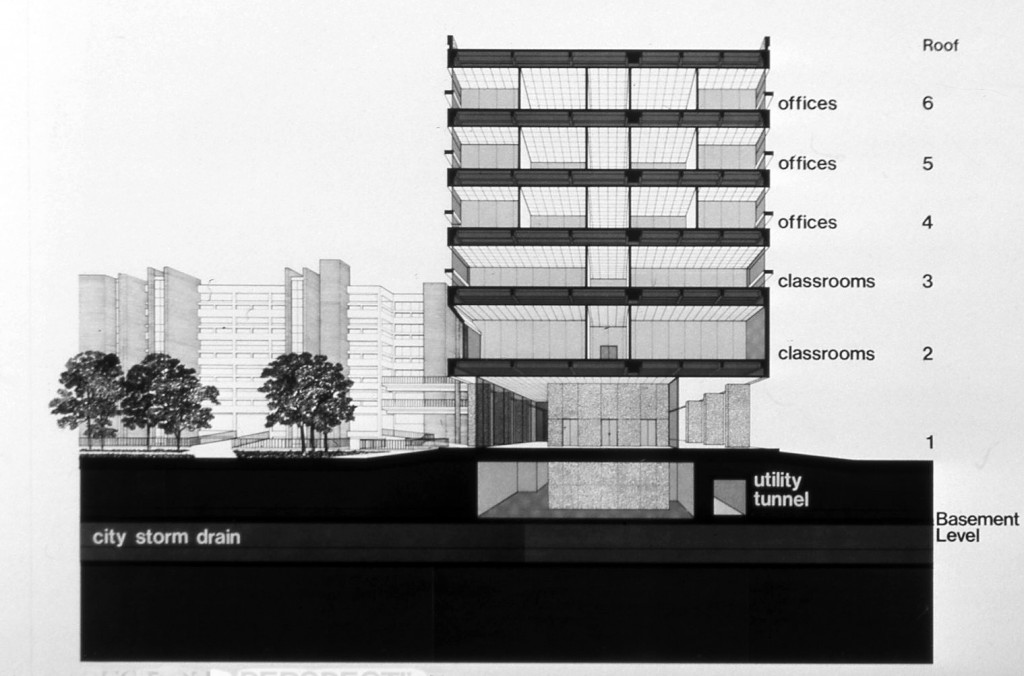
PGH, section view. Agnes Arnold Hall in background. Note storm drain below breezeway. Kenneth E. Bentsen Architectural Papers
But below the street was a major city storm sewer, and an easement prevented them from placing a building over it. Their solution was a building with a large hole in the center that left the area over the storm sewer open, providing access if it is ever needed. In the construction view below, looking to the southeast, excavation for a basement stops short of the center of the building.
![Philip G. Hoffman Hall Construction [UH Photographs Collection]](http://weblogs.lib.uh.edu/speccol/files/2014/07/PGH-Construction.jpg)
Construction of Philip G. Hoffman Hall (c. 1972) UH Photographs Collection
Finding Aid for the Cynthia Macdonald Papers Now Available Online
What does it mean to live the Writer’s Life? We often hold to the stereotype of the solitary writer, alone among her books in a cramped apartment above a laundromat or a Greek restaurant, hammering away at the keyboard (or better yet: typewriter) to the strains of the city outside her window, the cacophony of sirens and taxicabs and nightclub jazz and the whistle and scream of anguished souls on the streets below. Or the even more hermit-like author, tucked away in a mountain cabin, sitting in a rocking chair he carved himself while ruminating on the beautiful mysteries of Mother Nature and the folly of humankind.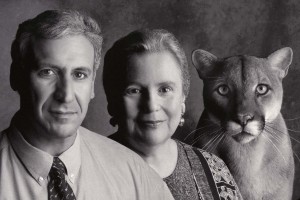
But there is another way, and Cynthia Macdonald, co-founder of the UH Creative Writing Program, has lived it. The Writer’s Life can be one that is fully engaged with the world around her. The writer can laugh and cry and struggle and celebrate with an unrelenting vigor. The writer can draw people into her orbit; can follow her curiosity down myriad paths to become an eclectic expert; can live firmly on the ground in the real world and turn its drudgeries and heartbreaks and ecstasies into Art.
The finding aid for the Cynthia Macdonald Papers is now available online, and the collection is a treasure trove for researchers, writing students, fans of Macdonald’s poetry, and anyone interested in seeing how a writer makes a go of it in this world.
Special Collections houses more than 45 boxes of Cynthia Macdonald’s work and personal materials. The collection includes multiple drafts of her 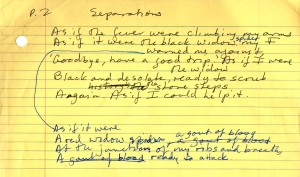 poems, both published and unpublished, both typed and handwritten, from scrawls on paper napkins and backs of envelopes to fully polished manuscripts. In addition to Macdonald’s writings, the collection also highlights the business and publicity surrounding a modern writer: contracts and royalty statements; writing proposals, grants, and awards; news clippings, book reviews, and poetry readings.
poems, both published and unpublished, both typed and handwritten, from scrawls on paper napkins and backs of envelopes to fully polished manuscripts. In addition to Macdonald’s writings, the collection also highlights the business and publicity surrounding a modern writer: contracts and royalty statements; writing proposals, grants, and awards; news clippings, book reviews, and poetry readings.
The abundance of correspondence is especially rich, featuring letters to and from Macdonald’s writing friends, teaching colleagues, and family members. Among the many noteworthy contributors are famous poets and writers such as Louise Erdrich, James Michener, Adrienne Rich, and Anne Sexton, as well as artists in other fields such as painter Helen Frankenthaler, photographer Gay Block, and singer Judy Collins.
The collection also provides a window into Macdonald’s long career as co-founder and teacher at UH’s acclaimed Creative Writing Program; her early, budding career as an opera singer; and her later, successful career as a professional psychoanalyst. The diligent researcher can also piece together other aspects of Macdonald’s life from a vast array of personal and family mementos and photographs, collected over almost the entire course of her life, from early childhood onward.
For more information about what is contained in the collection, be sure to take a look at the detailed finding aid. The original materials can be viewed in the Special Collections Reading Room.
So, what does it mean to live the Writer’s Life – or any life, for that matter? One way is to hunker down, hole up, and protect one’s writing and one’s heart in the safety of one’s own company, alone, but safe, but alone. Another way, though, as Cynthia Macdonald has demonstrated, is to reach out for all of life, to embrace life fiercely and expressly, to share bravely our thoughts and opinions and hearts with others, to write and live and write again and live some more, to dare to engage every aspect of the world around us, opening ourselves to the possibility of pain, yes, but to that of love as well.
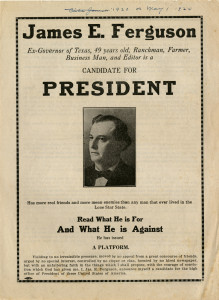
James E. Ferguson presidential candidate broadside, from the C.E. Texana Collection
Summertime, and the researchin’ is easy.
With apologies to George Gershwin, summer means research steps with a more urgent gait, attempting to make use of the dwindling days prior to the academic responsibilities of the fall semester. Today we take a look at some of the popular archives thus far in the summer of 2013 and, in doing so, hopefully spark some renewal of research projects of your own.
Popular collections which we have highlighted here recently include the Cheryl Crawford Papers and the Alonso S. Perales Papers. However, here are four collections with a little less limelight, yet brimming with potential, recently tapped by researchers:
1) Oral Histories – Houston History Project – Part of the Houston History Archives, this collection of interviews with history’s witnesses, produced in conjunction with the Center for Public History, documents the evolution of the greater Gulf Coast. Interviews with Houstonians provide first-hand accounts of the city’s civil rights, cultural, and political past.
2) President’s Office Records – Maybe not as glamorous as some of our other collections, the President’s Office Records from the University Archives dates back to the University’s founding in 1927 and is the starting point for anyone interested in the history of this great experiment in higher education that is the University of Houston.
3) Claude Elliott Texana Collection – Assembled as part of the Houston and Texas History collecting area, the C.E. Texana Collection represents the accumulation of materials from a writer, historian, and scholar specializing in Texas history.
4) Donald Barthelme Literary Papers and the Donald Barthelme “Forum” Collection – A name that has become synonymous with the experimental, short fiction of postmodernism, Donald Barthelme was instrumental in the establishment and growth of one of the most prestigious creative writing programs in the nation here at UH. Also of interest may be the Helen Moore Barthelme Papers and the Donald Barthelme, Sr. Architectural Papers in Architecture and Planning.
These collections and more are available for study in our Reading Room. Be sure to comb through some of our finding aids and hurry down before autumn leaves have you chasing other interests and obligations.
As noted recently on NPR, today marks the 125th anniversary of the publication of the classic baseball poem, “Casey at the Bat,” in 1888. One of our patrons heard the piece on the radio, and while visiting us in the Reading Room for some other research, asked if we might happen to have any materials related to this poem. A discussion ensued, and while we do not have any direct connection, a challenge was thrown down: Could we find a connection from “Casey at the Bat” to something in our archives in six steps, a la “Six Degrees of Separation”?
Well, here we go:
1. “Casey at the Bat” was written by Ernest Thayer.
2. Ernest Thayer was friends with William Randolph Hearst from their days together at the Harvard Lampoon – and Hearst later hired Thayer as humor columnist for the San Francisco Examiner, which first published “Casey” in 1888.
3. William Randolph Hearst was the inspiration for the renowned film Citizen Kane, directed by and starring Orson Welles.
4. Orson Welles exchanged correspondence with theater producer/director Cheryl Crawford; this correspondence is available right here in our archives among the Cheryl Crawford Papers.
Six degrees? Ha! We got there in four. So although there might be “no joy in Mudville,” as “mighty Casey has struck out,” we are feeling a bit victorious here in Special Collections today.
Interested researchers and visitors may view these letters and much more in our Reading Room. The bulk of the Cheryl Crawford Papers dates from 1940-1978, documenting Ms. Crawford’s career in theater through correspondence, production materials, scripts, programs, playbills, audio tapes, posters, sheet music, sound recordings, clippings, budgets, tax returns, legal agreements, contracts, audits, reviews, speeches, and miscellaneous items such as postcards and receipts.
Do you watch Mad Men? A lot of us here in Special Collections do, and we noticed that on last night’s episode (no spoilers here, we promise) the book that Don Draper is reading on the airplane is Larry McMurtry’s The Last Picture Show. Not only do we have in our stacks a copy of that exact edition in Draper’s hands (a first printing of the Dell paperback from 1967),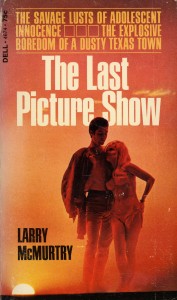 but we also have in our archives Larry McMurtry’s first draft of the typescript of the novel, complete with handwritten notes, a character list, an outline, and some discarded pages. Researchers and fans of McMurtry’s work can visit us here to follow the evolution of this novel from first draft to second draft to publisher’s copy, and compare these to the final published piece. (We highly recommend the 1971 film version of the book as well, available in the Anderson library’s DVD collection.)
but we also have in our archives Larry McMurtry’s first draft of the typescript of the novel, complete with handwritten notes, a character list, an outline, and some discarded pages. Researchers and fans of McMurtry’s work can visit us here to follow the evolution of this novel from first draft to second draft to publisher’s copy, and compare these to the final published piece. (We highly recommend the 1971 film version of the book as well, available in the Anderson library’s DVD collection.)
So, what does it mean for Don Draper to be reading The Last Picture Show? Well, we have some ideas, but don’t want to give away any spoilers in case you haven’t watched the episode yet.
